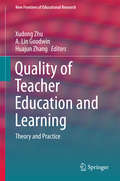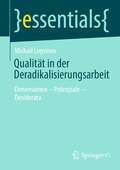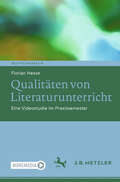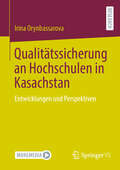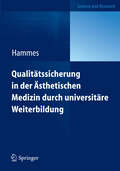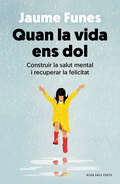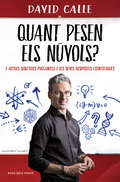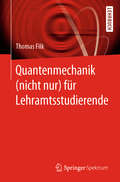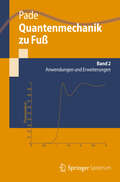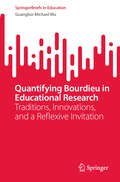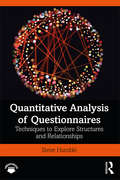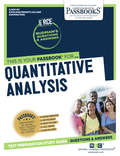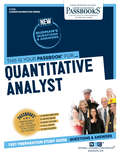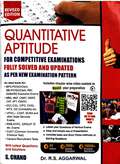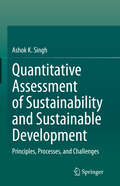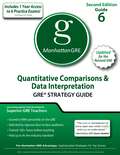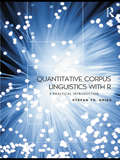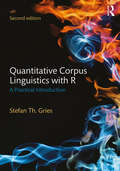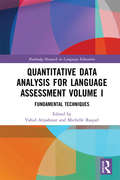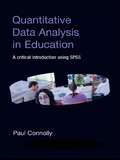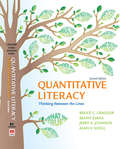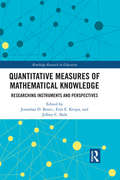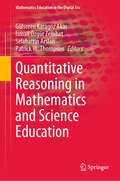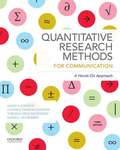- Table View
- List View
Quality of Teacher Education and Learning
by A. Lin Goodwin Xudong Zhu Huajun ZhangThis edited book is on the theory and practice of teacher education from the most distinguished and experienced scholars in the field around the world. In this book, they explored the most urgent and significant issues in teacher education in this globalized time. The dealing of these issues can directly impact the quality of teacher education and education in general. How to improve the quality of teacher education is a global issue that many countries, no matter developed or developing, face. This book provides multiple perspectives to address the challenges and possibilities for improving teacher quality. A point needs to further highlight in this book is that the researchers pay more attention to the inner landscape of teachers, such as the issue of identity, sense of person, etc. In this book, the readers can learn the insights and multiple perspectives of the best scholars in teacher education.
Qualität in der Deradikalisierungsarbeit: Dimensionen – Potenziale – Desiderata (essentials)
by Michail LogvinovDieses essential behandelt Potenziale und Handlungsbedarfe der Qualitätsförderung in der Deradikalisierungsarbeit. Durch die Benennung einzelner Qualitätsdimensionen und -kriterien wird ein praxisorientierter Beitrag zu den kontrovers diskutierten Themen Qualität, Wirkung und Effektivität von Maßnahmen geleistet. Als Vergleichsgrundlage fungieren dabei die Qualitätsdebatte in der Sozialen Arbeit, englischsprachige Forschungen zur Effektivität und Leistungsfähigkeit von Non-Profit-Organisationen, die Qualitätssicherung in der Kriminalprävention und die evidenzorientierte Erforschung der Umsetzungsqualität von Resozialisierungsprogrammen. Im Ergebnis wird eine Reihe von Ansätzen, Standards, Indikatoren und Prädiktoren diskutiert, die für die interne Qualitätsentwicklung der Fachpraxis einen Mehrwert ergeben.
Qualitäten von Literaturunterricht: Eine Videostudie im Praxissemester (Deutschdidaktik)
by Florian HesseWie gestalten Studierende im Praxissemester Literaturunterricht? Dieser Frage widmet sich Florian Hesse in einer explorativen Videostudie. Basierend auf Erkenntnissen der Unterrichts-, Professionalisierungs- und Praktikumsforschung entwickelt er ein Qualitätsmodell für den Literaturunterricht, welches die Grundlage für die Konzeption und Evaluation von Beobachtungsinstrumenten darstellt. Mit diesen wird der Unterricht mehrperspektivisch beschrieben und hinsichtlich seiner Qualität eingeschätzt. Aus den Befunden werden Hypothesen für die weitere Forschung abgeleitet und Schlussfolgerungen für die Lehrkräftebildung gezogen.
Qualitätssicherung an Hochschulen in Kasachstan: Entwicklungen und Perspektiven
by Irina OrynbassarovaDas vorliegende Buch setzt sich mit der Qualitätssicherung und dem -management an kasachischen Hochschulen seit der Verselbstständigung des Bildungssystems nach dem Zerfall der Sowjetunion auseinander. Das Ziel der Arbeit ist die intendierten und nicht-intendierten Effekte der ISO-Normen zu analysieren und die Faktoren, die zur Angleichung des QMS an kasachischen Hochschulen geführt haben sollen, zu identifizieren. Die Autorin stellt außerdem die historische Entwicklung des Hochschulwesens und die Reformen, die seit der Verselbstständigung im Gang sind, dar.
Qualitätssicherung in der Ästhetischen Medizin durch universitäre Weiterbildung
by Stefan HammesMit dem Buch werden die Standards für eine interdisziplinäre, universitäre und praxisorientierte Ausbildung in der ästhetischen Lasermedizin definiert. Das Beispiel des ersten Weiterbildungsstudienganges in Deutschland mit dem universitären Abschluss Diploma in Aesthetic Laser Medicine (DALM) zeigt, wie das Risikomanagement in der ästhetischen Medizin konkrete Form annehmen kann. Der Band enthält einen Fragenkatalog zur Vorbereitung auf die Prüfung.
Quan la vida ens dol: Construir la salut mental i recuperar la felicitat
by Jaume FunesQuan la vida ens dol és una reflexió rigorosa que vol ajudar les persones perquè prenguin consciència que una bona salut mental és part del camí que porta a seguir avançant cap a la felicitat. En un moment o altre de la vida apareixen els malestars. Habitualment, el magatzem de les experiències positives viscudes, les habilitats vitals apreses i la proximitat activa d'altres persones fan que els superem. Però hi ha vegades en què això no és així, i el dolor de viure encaixats en una existència que no volem fa que tot es trastorni. Sigui quina sigui la situació, ens trobem enmig d'alteracions d'una part de la salut, la mental, per a la qual no hi ha acord sobre com descriure-la, com explicar-la, com dedicar-hi l'atenció adequada. I acabem immersos en una mena de supermercat de les teràpies, en una gestió interessada dels fàrmacs, en una absència d'escolta i d'acompanyament. Aquest llibre pretén ajudar a tenir una visió personal més coherent sobre la salut i la malaltia mentals, a compartir un discurs social que aporti i que no segregui, a ampliar el grup dels professionals que comparteixen una visió integradora i que donen respostes que humanitzen, a exigir dels nostres responsables polítics una planificació coherent i no la venda d'etiquetes i de serveis etiquetats per curar les malalties mentals.
Quant pesen els núvols?: I altres senzilles preguntes i les seves respostes científiques
by David CalleDescobreix l'univers del professor estrella de YouTube que ha ajudat milers d'alumnes a perseguir els seus somnis. Finalista del Global Teacher Price i una de les persones més creatives del món, segons Forbes. Per què el veí de sota viurà més anys que tu?De quin color és un mirall? Quant pesa el martell de Thor?Per què no podem viatjar al passat?Quants megapíxels té l'ull humà? ------- - Llegir aquest llibre t'ocuparà el 0,0005% de la vida, entre uns 7.200 i uns 14.400 segons. Potser els mateixos que veure Blade Runner 2049 o la trilogia original de Star Wars. Tot i que ja saps que el temps és relatiu, com tantes altres coses. - Si gaudeixes d'una vida llarga i pròspera, viuràs més de dos mil milions de segons, malgrat que la tercera part d'aquest temps la passaràs dormint. La resta et tocarà estar despert, viure i gaudir, perquè pot ser apassionant. Així que rumia bé en què vols invertir aquests segons. - D'aquí a uns quants anys, algunes de les afirmacions que llegiràs en aquest llibre, avui dia considerades del tot certes, pot ser que ja no tinguin sentit. Res no és permanent, res no és constant. «L'únic constant és el canvi», va predir Heràclit ara fa 2.500 anys. És el meravellós de la ciència: que avança imparable dia rere dia. Per això vull que aquest llibre et serveixi d'inspiració i t'ajudi a construir els teus somnis, a iniciar la pròpia recerca de respostes a totes les preguntes que et passin pel cap sense haver d'apel·lar als déus de l'Olimp, que sempre aporten una resposta o altra, mitològica i fascinant, però no gens científica. ------ A quina temperatura bull l'aigua al cim de l'Everest? Quina llei física transgredeixen les naus de Star Wars? Com podríem escapar-nos de la Terra? Ens dominaran els robots? Per què el cel és blau? Per què no podem viatjar al passat? Per què l'univers i la teva habitació tendeixen sempre al màxim desordre? Serem cíborgs en un futur? Quina alçària màxima pot assolir un castell de sorra? Quants diners costaria endur-se una pilota de futbol a l'espai? Quantes pomes va esmicolar Galileu per experimentar amb la gravetat? Quantes aranyes calen per frenar un Boeing 747? Què passaria si s'invertissin els pols de la Terra? Per què s'escalfa la Terra? Com seran els mapes del futur?
Quantenmechanik (nicht nur) für Lehramtsstudierende
by Thomas FilkDieses Lehrbuch zur Quantentheorie ist speziell für Lehramtsstudierende konzipiert und auf die Bedürfnisse zukünftiger Lehrer und Lehrerinnen zugeschnitten. Die konzeptuellen Grundlagen, aber auch die Darstellung des mathematischen Formalismus der Quantenphysik stehen dabei im Vordergrund, gleichzeitig wird weniger Wert auf eine detaillierte Beschreibung der mathematischen Techniken zur Lösung spezifischer Probleme gelegt.Im ersten, einführenden Teil des Buches werden mögliche Zugänge zur Quantenmechanik beschrieben. Diese bieten dem Leser nicht nur zu Beginn verschiedene Perspektiven, aus denen man die Quantentheorie betrachten kann, sondern können auch mit den notwendigen didaktischen Änderungen in der Schule verwendet werden. Teil II umfasst den eigentlichen Lehrstoff, wie er in Vorlesungen an der Hochschule vermittelt wird: Vom mathematischen Rüstzeug über die Postulate bis hin zur Anwendung auf einfache Systeme, darunter das Kastenpotential, den harmonischen Oszillator und das Wasserstoffatom. Das Grundwissen der Quantenmechanik wird hier nachvollziehbar und verständlich erklärt. Der dritte und abschließende Teil bietet eine Sammlung von weiterführenden, voneinander unabhängigen Themen mit ausführlicheren Hintergründen zu den Grundlagen und Anwendungen. Kapitel zu offenen Fragen, Problemen und Interpretationen der Quantentheorie, Quantenlogik aber auch tiefer gehende Betrachtungen der mathematischen Zusammenhänge ermöglichen so ein erweitertes Verständnis.Mit Hilfe von Übungsaufgaben können Studierende das Gelernte überprüfen und in der Anwendung festigen. Die Lösungen zu den Aufgaben sowie weitere Aufgaben werden online bereitgestellt.
Quantenmechanik zu Fuß 1
by Jochen PadeDas Lehrbuch bietet eine Einführung in die Grundlagen der nicht-relativistischen Quantenmechanik. Der Autor stellt Standardthemen kombiniert mit neuen Entwicklungen dar und schafft so einen neuen Zugang zum Thema. Die Hilfsmittel für die mathematische Formulierung der wesentlichen Prinzipien der Quantenmechanik erläutert er schrittweise. Weiterführende Themen wie z. B. der Quanten-Zeno-Effekt werden im Anhang behandelt. Der Band enthält 250 Aufgaben und ist insbesondere für Studierende geeignet, die nicht den Schwerpunkt Theorie gewählt haben.
Quantifying Bourdieu in Educational Research: Traditions, Innovations, and a Reflexive Invitation (SpringerBriefs in Education)
by Guanglun Michael MuThis book revolves around the rationale, urgency, and application of quantifying Bourdieu in educational research. It begins with a succinct revisit to Bourdieu’s methodological pluralism and quantitative program, and a critical review of existing but limited Bourdieusian quantitative educational studies, establishing the theoretical, methodological, and contextual foundations for empirical applications of quantitative methodology in Bourdieusian educational research. The book then presents three examples of such empirical applications as individual chapters, utilising multiple correspondence analysis and social network analysis. These chapters respectively examine social class and educational mobility, teacher resilience and teacher education, and social grouping and social change. The book concludes with a proposal to mobilise a range of 'relational' quantitative methodologies – including factor analysis, cluster analysis, logistic regression, multilevel modelling, and cross-lagged panel model – within a Bourdieusian remit, and extends a reflexive invitation to quantify Bourdieu in educational research.
Quantitative Analysis of Questionnaires: Techniques to Explore Structures and Relationships
by Steve HumbleBringing together the techniques required to understand, interpret and quantify the processes involved when exploring structures and relationships in questionnaire data, Quantitative Analysis of Questionnaires provides the knowledge and capability for a greater understanding of choice decisions. The ideal companion for non-mathematical students with no prior knowledge of quantitative methods, it highlights how to uncover and explore what lies within data that cannot be achieved through descriptive statistics. This book introduces significance testing, contingency tables, correlations, factor analysis (exploratory and confirmatory), regression (linear and logistic), discrete choice theory and item response theory. Using simple and clear methodology, and rich examples from a range of settings, this book: provides hands-on analysis with data sets from both SPSS and Stata packages; explores how to articulate the calculations and theory around statistical techniques; offers workable examples in each chapter with concepts, applications and proofs to help produce a higher quality of research outputs; discusses the use of formulas in the appendix for those who wish to explore a greater mathematical understanding of the concepts. Quantitative Analysis of Questionnaires is the ideal introductory textbook for any student looking to begin and or improve statistical learning as well as interpretation.
Quantitative Analysis: Passbooks Study Guide (Excelsior/Regents College Examination Series)
by National Learning CorporationThe Excelsior/Regents College Examinations (E/RCE) offer you an opportunity to obtain recognition for college-level learning and consists of exams designed to demonstrate achievement and mastery of various college-level subjects, such as the Arts and Sciences, Business, Criminal Justice, Education, Health and Nursing. The E/RCE Quantitative Analysis Passbook® prepares you by sharpening knowledge of the skills and concepts necessary to succeed on the upcoming exam and the college courses that follow. It provides a series of informational texts as well as hundreds of questions and answers in the areas that will likely be covered on your upcoming exam.
Quantitative Analyst: Passbooks Study Guide (Career Examination Series #C-1797)
by National Learning CorporationThe Quantitative Analyst Passbook® prepares you for your test by allowing you to take practice exams in the subjects you need to study. It provides hundreds of questions and answers in the areas that will likely be covered on your upcoming exam, including but not limited to: discriptive and inferential statistics; fundamentals of microcomputer systems; preparing written material; research and experimental design; and other related areas.
Quantitative Aptitude - 2024 Edition - Competitive Exam
by Dr R. S. AggarwalThe reference book Quantitative Aptitude for Competitive Examinations by Dr. R.S. Aggarwal, published by S. Chand and Company Limited, is designed for candidates preparing for a wide range of competitive exams such as IBPS, SBI, RBI, SSC, UPSC, and more. It provides comprehensive coverage of mathematical topics essential for quantitative reasoning, with over 2000 solved examples and more than 10,000 practice questions. The content is organized by topics such as the number system, HCF and LCM, decimal fractions, simplifications, square roots, and various types of arithmetic problems. It also includes shortcuts, detailed solutions, video content, and mock tests for thorough exam preparation.
Quantitative Assessment of Sustainability and Sustainable Development: Principles, Processes, and Challenges
by Ashok K. SinghThis volume discusses and analyses the use of quantitative indicators to assess sustainability across sectors, with the goal of offering readers the tools to choose and validate indicators. Sustainability (SU) and sustainable development (SD) are critical for survival of humanity, but fraught with both definitional and measurement issues. SU and SD are complex multidimensional processes exhibiting (i) social, cultural, and economic variabilities, (ii) a lack of unified definition, and (iii) conceptual vagueness. These deficiencies complicate attempts to measure the effectiveness of SU/SD efforts and make comparisons across programs and geographies difficult. This book explains, in clear terms, the causes, consequences, and assessment of SU and SD deficiencies. An indicator developed for one geographical or climate region may or may not accurately assess sustainability status of another system in different region. That is why, in spite of plenty indicators currently available, there is a need to validate existing or new indicators to assess sustainability. This book develops a database of indicators targeting different aspects of SU and SD and discusses the indicators’ elasticity, range, advantages and disadvantages. The book also provides theoretical and applied information regarding selection of indicators online and/or design new indicators. This volume is targeted toward faculty and graduate/postgraduate scholars working in research areas relevant to sustainability, especially those looking for assessment methodologies and advice on selection and validation of relevant indicators.
Quantitative Comparisons & Data Interpretations Math GRE Strategy Guide
by Manhattan Gre StaffUpdated for the revised GRE, this guide is really two books in one, thoroughly covering two of the quantitative question types on the GRE. The Guide to Quantitative Comparisons provides students a framework for understanding what Quantitative Comparisons questions tests. Most importantly, it discusses time-saving strategies specific to the Quantitative Comparisons format. The Guide to Data Interpretation presents an overview of the types of graphs students can expect to see on the GRE. It also discusses the different types of questions typically seen on the GRE and provides guidelines for reading graphs and combining information from different graphs to answer questions. Purchase of this book includes one year of access to 6 of Manhattan GRE's online practice exams.
Quantitative Corpus Linguistics with R: A Practical Introduction
by Stefan Th. GriesThe first textbook of its kind, Quantitative Corpus Linguistics with R demonstrates how to use the open source programming language R for corpus linguistic analyses. Computational and corpus linguists doing corpus work will find that R provides an enormous range of functions that currently require several programs to achieve – searching and processing corpora, arranging and outputting the results of corpus searches, statistical evaluation, and graphing.
Quantitative Corpus Linguistics with R: A Practical Introduction
by Stefan Th. GriesAs in its first edition, the new edition of Quantitative Corpus Linguistics with R demonstrates how to process corpus-linguistic data with the open-source programming language and environment R. Geared in general towards linguists working with observational data, and particularly corpus linguists, it introduces R programming with emphasis on: data processing and manipulation in general; text processing with and without regular expressions of large bodies of textual and/or literary data, and; basic aspects of statistical analysis and visualization. This book is extremely hands-on and leads the reader through dozens of small applications as well as larger case studies. Along with an array of exercise boxes and separate answer keys, the text features a didactic sequential approach in case studies by way of subsections that zoom in to every programming problem. The companion website to the book contains all relevant R code (amounting to approximately 7,000 lines of heavily commented code), most of the data sets as well as pointers to others, and a dedicated Google newsgroup. This new edition is ideal for both researchers in corpus linguistics and instructors who want to promote hands-on approaches to data in corpus linguistics courses.
Quantitative Data Analysis for Language Assessment Volume I: Fundamental Techniques (Routledge Research in Language Education)
by Vahid Aryadoust Michelle RaquelQuantitative Data Analysis for Language Assessment Volume I: Fundamental Techniques is a resource book that presents the most fundamental techniques of quantitative data analysis in the field of language assessment. Each chapter provides an accessible explanation of the selected technique, a review of language assessment studies that have used the technique, and finally, an example of an authentic study that uses the technique. Readers also get a taste of how to apply each technique through the help of supplementary online resources that include sample data sets and guided instructions. Language assessment students, test designers, and researchers should find this a unique reference as it consolidates theory and application of quantitative data analysis in language assessment.
Quantitative Data Analysis for Language Assessment Volume II: Advanced Methods
by Vahid Aryadoust Michelle RaquelQuantitative Data Analysis for Language Assessment Volume II: Advanced Methods emonstrates advanced quantitative techniques for language assessment. The volume takes an interdisciplinary approach and taps into expertise from language assessment, data mining, and psychometrics. The techniques covered include Structural Equation Modeling, Data Mining, Multidimensional Psychometrics and Multilevel Data Analysis.Volume II is distinct among available books in language assessment, as it engages the readers in both theory and application of the methods and introduces relevant techniques for theory construction and validation. This book is highly recommended to graduate students and researchers who are searching for innovative and rigorous approaches and methods to achieve excellence in their dissertations and research. It is also a valuable source for academics who teach quantitative approaches in language assessment and data analysis courses.
Quantitative Data Analysis in Education: A Critical Introduction Using SPSS
by Paul ConnollyThis book provides a refreshing and user-friendly guide to quantitative data analysis in education for students and researchers. It assumes absolutely no prior knowledge of quantitative methods or statistics. Beginning with the very basics, it provides the reader with the knowledge and skills necessary to be able to undertake routine quantitative data analysis to a level expected of published research. Rather than focusing on teaching statistics through mathematical formulae, the book places an emphasis on using SPSS to gain a real feel for the data and an intuitive grasp of the main concepts and techniques involved. Drawing extensively upon up-to-date and relevant examples, the reader will be encouraged to think critically about quantitative research and its potential as well as its limitations in relation to education. Packed with helpful features, this book: provides illustrated step-by-step guides showing how to use SPSS, with plenty of exercises to encourage the reader to practice and consolidate their new skills makes extensive use of real-life educational datasets derived from national surveys in the US and UK to illustrate key points and to bring the material to life has a companion website that contains all of the educational datasets used in the book to download as well as comprehensive answers to exercises and a range of other useful resources that are regularly updated. The book will therefore appeal not only to undergraduate and postgraduate students but also to more established and seasoned educational researchers and lecturers and professors who have tended to avoid or shy away from quantitative methods.
Quantitative Literacy
by Benny Evans Bruce C. Crauder Jerry A. Johnson Alan V. Noell"I finally understand why I need to learn some math!" says a student after finishing a course that used Quantitative Literacy. That enthusiastic response gets to the heart of how this remarkable textbook works. Quantitative Literacy shows students that they use math in their everyday lives more than they realize, and that learning math in real-world contexts not only makes it easier to get better grades, but prepares them for decisions they'll face about money, voting and politics, health issues, and much more. The authors draw on a wide range of examples to give students basic mathematical tools-- from sports to personal finance to sociopolitical action to medical tests to the arts--with coverage that neatly balances discussions of ideas with computational practice.
Quantitative Measures of Mathematical Knowledge: Researching Instruments and Perspectives (Routledge Research in Education #43)
by Jonathan Bostic Erin Krupa Jeffrey ShihThe aim of this book is to explore measures of mathematics knowledge, spanning K-16 grade levels. By focusing solely on mathematics content, such as knowledge of mathematical practices, knowledge of ratio and proportions, and knowledge of abstract algebra, this volume offers detailed discussions of specific instruments and tools meant for measuring student learning. Written for assessment scholars and students both in mathematics education and across educational contexts, this book presents innovative research and perspectives on quantitative measures, including their associated purpose statements and validity arguments.
Quantitative Reasoning in Mathematics and Science Education (Mathematics Education in the Digital Era #21)
by Patrick W. Thompson Gülseren Karagöz Akar İsmail Özgür Zembat Selahattin ArslanThis book focuses on quantitative reasoning as an orienting framework to analyse learning, teaching and curriculum in mathematics and science education. Quantitative reasoning plays a vital role in learning concepts foundational to arithmetic, algebra, calculus, geometry, trigonometry and other ideas in STEM. The book draws upon the importance of quantitative reasoning and its crucial role in education. It particularly delves into quantitative reasoning related to the learning and teaching diverse mathematics and science concepts, conceptual analysis of mathematical and scientific ideas and analysis of school mathematics (K-16) curricula in different contexts. We believe that it can be considered as a reference book to be used by researchers, teacher educators, curriculum developers and pre- and in-service teachers.
Quantitative Research Methods for Communication: A Hands-On Approach
by Jason S. Wrench James C. McCroskey Virginia Peck Richmond Candice Thomas-MaddoxThis book is a comprehensive and engaging guide to quantitative research. Drawing on their extensive research and teaching experience, the authors encourage students to take an active, hands-on role in the learning process. After giving students the tools they need to locate, conduct, collect, and present their research, the text provides them with the opportunity to immediately apply these skills in research scenarios.
